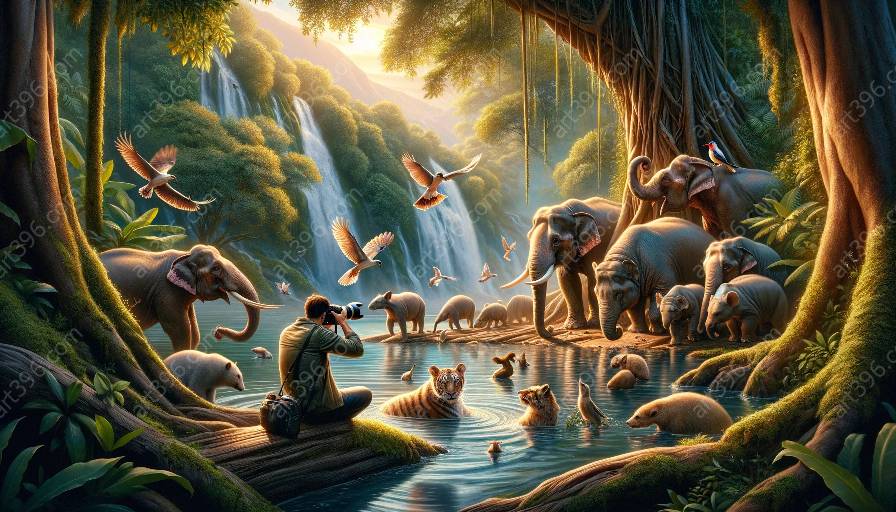Wildlife photography presents unique challenges, especially in low-light conditions. Capturing sharp, clear images in these settings requires careful consideration of exposure, equipment, and post-processing techniques. When it comes to minimizing noise in low-light wildlife photography, photographers can implement various strategies to achieve exceptional results. From understanding the fundamental principles of exposure to leveraging advanced technology, there are numerous tips and tricks that can help photographers capture stunning wildlife images with minimal noise interference.
Understanding Noise in Photography
Before delving into techniques for minimizing noise in wildlife photography, it's crucial to have a basic understanding of what noise is and how it affects images. Noise, often characterized by grain or pixelation, appears in photographs as unwanted, random variations in brightness and color. In low-light conditions, such as those encountered in wildlife photography, noise becomes more prevalent due to the limited available light. This can result in loss of detail and overall image quality.
Factors Contributing to Noise in Low-Light Wildlife Photography
When shooting wildlife in low-light scenarios, several factors can contribute to the presence of noise in the final images. Understanding these factors is essential for photographers seeking to minimize noise and achieve high-quality results:
- High ISO Settings: In low-light conditions, photographers often need to increase the camera's ISO setting to capture enough light. However, higher ISO settings can introduce more noise into the images.
- Underexposure: Incorrect exposure settings may lead to underexposed images, prompting photographers to brighten the images in post-processing. This can amplify any existing noise.
- Long Exposures: Wildlife photography frequently involves long exposures, particularly when capturing nocturnal animals. Longer exposure times can increase the likelihood of noise, especially in digital cameras.
Techniques for Minimizing Noise in Low-Light Wildlife Photography
Minimizing noise in low-light wildlife photography requires a combination of technical knowledge, proper equipment, and practical shooting and post-processing techniques. By integrating the following strategies into their workflow, photographers can significantly improve the clarity and quality of their wildlife images:
Use the Lowest Possible ISO Setting
When working in low-light conditions, it's essential to use the lowest ISO setting possible to minimize noise. While higher ISO settings can brighten the image, they also introduce more noise. By utilizing lower ISO values and compensating with other exposure settings, photographers can achieve cleaner, more detailed images.
Optimize Exposure Settings
Proper exposure is critical for minimizing noise in low-light wildlife photography. By utilizing the camera's histogram to ensure optimal exposure, photographers can avoid underexposure and subsequent noise issues. Balancing the exposure triangle—consisting of aperture, shutter speed, and ISO—can help achieve the desired results without introducing unnecessary noise.
Utilize Noise Reduction Technology
Many modern digital cameras offer built-in noise reduction technology to combat the effects of noise in low-light conditions. By enabling this feature, photographers can mitigate noise during image capture, resulting in cleaner images straight out of the camera.
Invest in High-Quality Lenses and Camera Bodies
Choosing high-quality lenses and camera bodies can significantly impact the noise performance of wildlife photography equipment. Opting for lenses with larger apertures and superior optical elements can improve light-gathering capabilities, reducing the need for high ISO settings and minimizing noise. Additionally, advanced camera bodies with enhanced sensor technology and low-light performance can deliver cleaner images even in challenging conditions.
Consider Capturing RAW Images
Shooting in RAW format provides the flexibility to leverage advanced post-processing techniques and noise reduction tools. RAW files retain a higher level of image data, allowing photographers to address noise issues more effectively during the editing process.
Employ Image Stacking Techniques
Image stacking involves combining multiple images of the same subject to create a single, noise-free composite. This technique is particularly useful in low-light wildlife photography, as it can significantly reduce noise by averaging out random variations present in individual exposures.
Post-Processing Noise Reduction
After capturing wildlife images in low-light conditions, photographers can further minimize noise through post-processing techniques. Utilizing specialized noise reduction software and editing tools, photographers can fine-tune their images to achieve exceptional clarity and detail. Key post-processing steps for noise reduction include:
- Utilizing Noise Reduction Tools: Dedicated noise reduction software, such as Adobe Lightroom or DxO PhotoLab, offers advanced tools for reducing noise while preserving image detail. By selectively applying noise reduction adjustments, photographers can effectively address noise issues without sacrificing image sharpness.
- Applying Sharpening Techniques: In conjunction with noise reduction, applying appropriate sharpening techniques can enhance the clarity and definition of wildlife images. Balancing noise reduction with sharpening helps maintain detail and texture, resulting in natural-looking, noise-free photographs.
Conclusion
Effective noise reduction in low-light wildlife photography is essential for capturing high-quality, professional-grade images. By understanding the fundamental principles of exposure, leveraging advanced technology, and implementing strategic shooting and post-processing techniques, photographers can minimize noise and produce exceptional wildlife photographs. Whether it's through optimizing exposure settings, investing in high-quality equipment, or utilizing post-processing tools, minimizing noise in low-light conditions equips photographers to showcase the beauty and splendor of wildlife in stunning detail.



















































